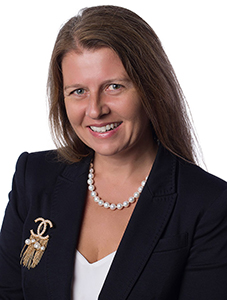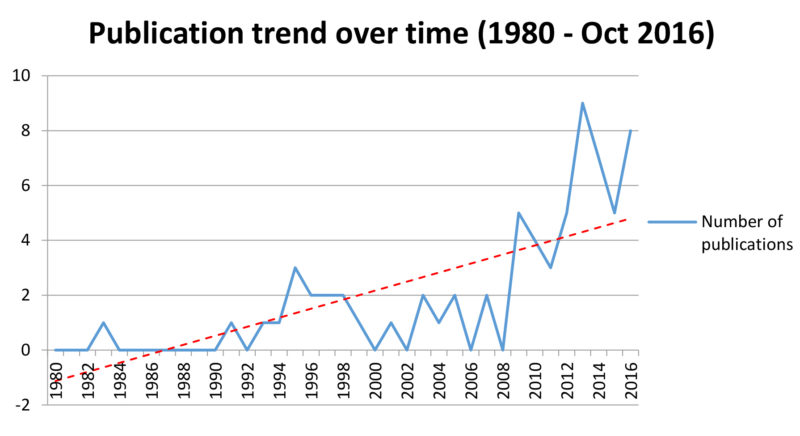Individuals diagnosed with Autism spectrum disorder (ASD), currently estimated to occur in one in every 68 births (CDC, 2014), exhibit varying degrees of intellectual ability and social delay. Like other aspects of the diagnosis, typified and challenged by heterogeneity, sexuality is a variable issue. For some, inappropriate behaviors of a sexual nature may limit their ability to engage in education, employment, or social activities. Education addressing appropriate sexual behavior is essential in order to optimise outcomes for all individuals on the autism spectrum. Parents, teachers, caregivers and individuals with ASD are all important stakeholders in the process of sex education.

Monica E. Carr, PhD
A systematic review of peer-reviewed literature that explored issues related to sexuality, sex education and individuals with ASD was conducted by Carr & Anderson (in review). The authors identified 118 articles for review, however omitted 50 studies that met keyword criteria but did not adhere to the theme of their review. Carr & Anderson developed a final data set of 68 studies for their review.
Figure 1 illustrates the number of peer-reviewed empirical publications addressing the topic of sexuality, sex education, and ASD for the 68 articles published between 1980 and Oct, 2016 (Carr & Anderson, in review). While the trend line indicates a steady increase in the number of publications across the time period, the data line illustrates a recent surge in the number of empirical studies published in peer-reviewed journals since 2008.

Figure 1. Publication trend of sexuality, sex education and ASD
Carr and Anderson reported that the majority of studies, 60 of 68 (88.3%), adhered to five main research themes. Their review identified thirty-two studies (47.1%) that examined stakeholder perceptions of sexuality of individuals with ASD, the largest of the five themes. Most encouragingly, individuals themselves have been given a voice, with 14 studies reflecting self-reports of sexuality. Parent-perceptions of sexuality of their child with ASD was explored in 10 studies, and other care-giver perceptions was explored in 8 studies.
Carr and Anderson reported that the second largest theme of their review related to individuals with ASD as sex offenders. Of the nine studies (13.2%) that reported on this issue, one was published in 2016, two in 2014, three in 2016 and three in 2009. The third and fourth largest themes each reported eight studies (11.8%) respectively. A total of eight studies examined issues surrounding the vulnerability of individuals with ASD who have been victims of sexual abuse. The earliest of these studies was published in 1994, the most recent in 2015.
Another eight studies examined training programs, with four studies describing program evaluation and issues relating to capacity building within programmes, and four describing the delivery of training programmes to individuals with ASD.
In the fifth most significant theme of their review, Carr and Anderson noted three studies (4.4%) had examined the use of medications to treat inappropriate sexual behaviour (Coskun, Karakoc, Kircelli, & Mukaddes, 2009; Realmuto & Ruble, 1999; Prasher & Clarke, 1996).
In their systematic review of the literature, Carr and Anderson cite many empirical studies that may be helpful to a wide audience of stakeholders concerned with sexual education for individuals with ASD. A summary of significant studies identified in their review, addressing the themes of perceptions of sexuality, sex offences, sexual victimisation, and training follows.
Byers, Nichols, and Voyer (2013) explored the sexuality of single adults with high functioning autism or Asperger’s syndrome using an online questionnaire. Byers et al. reported that in general, positive experiences were described and further noted that men reported better sexual function than women. In addition, Byers et al. noted that their findings are useful in countering negative societal perceptions about the sexuality of high functioning individuals on the spectrum.
Gilmour, Schalomon, & Smith (2012) administered an online survey of sexual knowledge and experiences. Reporting on responses drawn from 82 adults with autism and 282 adults drawn from the general population, Gilmour et al. found no significant differences in breadth and strength of sexual behaivors and comprehension of sexual language when compared to participants without ASD.
Holmes & Hilme (2014) explored communication regarding sexuality between parents and their children with ASD, and noted that experts recommend that parents be the primary source of sex education for adolescents with ASD. In particular, Holmes & Hilme emphasised the importance of tailoring sex education to the individual child’s level of development.
Lindsay et al. (2014) examined 477 sexual offence case referrals to forensic intellectual disability services. Lindsay et al reported that individuals with ASD showed a lower prevalence of contact sexual offences when compared to those without ASD, and concluded that there is no persuasive evidence that ASD is a risk factor for offending behaviours.
In other research, a questionnaire was given to 95 adults with ASD and 117 adults without ASD to gather data on sexual knowledge sources, actual knowledge, perceived knowledge, and sexual victimisation (Brown-Lavoie, Viecili, & Weiss, 2014). Brown-Lavoie et al. reported that the individuals with ASD acquired their sexual information less from social resources, more from non-social sources, had less perceived and actual knowledge, and were subjected to more sexual victimisation than the control group. Brown-Lavoie et al. noted that sexual victimisation of individuals with ASD was partially mediated by their actual knowledge.
A research team in India developed a sex and health curriculum, reflective of Indian cultural values, in effort to reduce problem and odd sexual behaviors in individuals with ASD (Banerjee, Ray, & Panda, 2013). A sample of 45 individuals drawn from special education schools received 40 Sex and Health Education lessons, once per week, that lasted 40-60 minutes. Five domains were included in the curricula: biology and personal appearance; privacy/modesty regarding sexual expression; health/hygiene and personal care; recognition of emotion; and social behaviour. Banerjee et al. reported that the program had a positive effect in handling the expression of sexual urge in a socially acceptable manner, and had positive effects on both odd sexual and problem behaviours.
Klett and Turan (2012) conducted a pilot study with three girls with ASD, in which parents implemented a Social Story based intervention, embedded with a visual task analysis, to teach their daughters menstrual care. Klett and Turan reported that the participants were more knowledgeable about reproductive development, and were able to independently care for themselves.
Dozier et al. (2011) used a single-subject research design, and conducted a functional analysis of an inappropriate sexual behavior (ISB) that had prevailed for 20 years, for a 36 year old participant with little expressive language. The participant was known to drop to the floor and engage in ISB when in the presence of a woman wearing sandals. Dozier et al. describe the implementation of a response interruption (to the target behaviour) followed by a time out procedure (RI/TO), and reported that the RI/TO procedure quickly eliminated the problem behaviour in multiple settings.
Carr and Anderson provide additional information on the topic of sexuality, sex education and amelioration of inappropriate behaviours, for individuals with ASD in their forthcoming systematic literature review.
Dr. Monica E. Carr is a Research Fellow at The University of Melbourne, Australia, and Member of the Board of Directors, Genesis School for Special Education, Singapore. For more information, please email mcarr.phd@gmail.com.
References
Byers, E. S., Nichols, S., Voyer, S. D., & Reilly, G. (2013). Sexual well-being of a community sample of high-functioning adults on the autism spectrum who have been in a romantic relationship. Autism, 17(4), 418-433.
Banerjee, M., Ray, P., & Panda, A. (2013). Role of sex education on odd sexual and problem behaviour: A study on adolescents with autism. Indian Journal of Community Psychology, 9(1), 1-20.
Brown-Lavoie, S. M., Viecili, M. A., & Weiss, J. A. (2014). Sexual knowledge and victimization in adults with autism spectrum disorders. Journal of Autism and Developmental Disorders, 44(9), 2185-2196.
Carr, M. E. & Anderson, A. Sexuality, sex education and individuals with Autism Spectrum Disorder: A systematic literature review (in review).
CDC, MMWR. (2014). Prevalence of autism spectrum disorder among children aged 8 years – autism and developmental disabilities monitoring network, 11 sites, United States, 2010. Morbidity and mortality weekly report. Surveillance summaries (Washington, D. C.: 002), 63(2), 1-21. Retrieved from http://www.ncbi.nlm.nih.gov/pubmed/24670961. July 7, 2014.
Coskun, M., Karakoc, S., Kircelli, F., & Nahit, M. (2009). Effectiveness of mirtazapine in the treatment of inappropriate sexual behaviours in individuals with autistic disorder. Journal of Child and Adolescent Psychopharmacology, 19(2), 203-206.
Dozier, C. L., Iwata, B. A., & Worsdell, A. S. (2011). Assessment and treatment of foot-shoe fetish displayed by a man with autism. Journal of Applied Behavior Analysis, 44(1), 133-137.
Gilmour, L., Schalomon, P. M., & Smith, V. (2012). Sexuality in a community based sample of adults with autism spectrum disorder. Research in Autism Spectrum Disorders, 6(1), 313-318.
Holmes, L. G., & Himle, M. B. (2014). Brief report: Parent-child sexuality communication and autism spectrum disorders. Journal of Autism and Developmental Disorders, 44(11), 2964-2970.
Klett, L. S., & Turan, Y. (2012). Generalized effects of social stories with task analysis for teaching menstrual care to three young girls with autism. Sexuality and Disability, 30(3), 319-336.
Lindsay, W. R., Carson, D., O’Brien, G., Holland, A. J., Taylor, J. L., Wheeler, J. R., & Steptoe, L. (2014). A comparison of referrals with and without autism spectrum disorder to forensic intellectual disability services. Psychiatry, Psychology and Law, 21(6), 947-954.
Prasher, V. P., & Clarke, D. J. (1996). Case report: Challenging behaviour in a young adult with Down’s syndrome and autism. British Journal of Learning Disabilities, 24(4), 167-169.
Realmuto, G. M., & Ruble, L. A. (1999). Sexual behaviors in autism: Problems of definition and management. Journal of Autism and Developmental Disorders. 29(2), 121-127.




